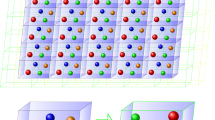Abstract
Crystal orientation is an important factor when we consider microstructures in materials. With respect to a reference frame, certain crystal orientation can be expressed by a rotation angle \(\Phi \) around a unit vector \(\mathbf{n}=\left( {h,\hbox { }k,\hbox { }l} \right) \). Partitioning of \(\Phi \) into rotation components around coordinate axes of the reference frame is discussed. For a rotation matrix \(\mathbf{R}\) corresponding to the axis/angle pair, its logarithm \(\ln \mathbf{R}\) is a skew symmetric tensor with three independent elements, \(h\Phi , k\Phi \) and \(l\Phi \). It is shown that these elements can be interpreted to be sums of the divided rotation angles around the coordinate axes. The elements \(h\Phi , k\Phi \) and \(l\Phi \) of \(\ln \mathbf{R}\) called the log angles can be used as the rotation components to evaluate crystal orientation in materials.





Similar content being viewed by others
References
N. Hansen, Metall. Mater. Trans. A 32, 2917–2935 (2001)
W. Pantleon, Acta Mater. 46, 451–456 (1998)
W. Pantleon, Mater. Sci. Eng. A 319, 211–215 (2001)
M. Ferry, F.J. Humphreys, Mater. Sci. Eng. A 435, 447–452 (2006)
A. Yoshida, Y. Miyajima, S. Onaka, J. Jpn. Inst. Met. 77, 435–439 (2013)
A. Yoshida, Y. Miyajima, S. Onaka, J. Mater. Sci. 49, 2013–2017 (2014)
J.A. Wert, Acta Mater. 50, 3125–3139 (2002)
Q. Liu, C. Maurice, J. Driver, N. Hansen, Metall. Mater. Trans. A 29, 2333–2344 (1998)
Q. Liu, J. Wert, N. Hansen, Acta Mater. 48, 4267–4279 (2000)
H. Grimmer, Acta Cryst. A 40, 108–112 (1984)
E. Pina, Eur. J. Phys. 32, 1171–1178 (2011)
K. Hayashi, M. Osada, Y. Kurosu, Y. Miyajima, S. Onaka, Mater. Trans. 57, 507–512 (2016)
S. Onaka, T. Hirose, H. Kato, S. Hashimoto, J. Jpn. Inst. Met. 61, 574–579 (1997)
U.F. Kocks, C.N. Tomé, H.-R. Wenk, Texture and Anisotropy Preferred Orientations in Polycrystals and their Effect on Materials Properties (Cambridge University Press, Cambridge, 2000), pp. 57–77
D.H. Sattinger, O.L. Weaver, Lie Groups and Algebras with Applications to Physics, Geometry, and Mechanics (Springer, New York, 1986), pp. 32–38
J.E. Marsden, T.S. Ratiu, Introduction to Mechanics and Symmetry, Second Edition (Springer, New York, 1999), pp. 283–308
B.C. Hall, Lie Groups, Lie Algebras, and Representations: An Elementary Introduction (Springer, New York, 2003), pp. 27–62
P. Neumann, Textures Microstruct. 14, 53–58 (1991)
J.P. Hirth, J. Lothe, Theory of Dislocations, 2nd edn. (Wiley, New York, 1982), pp. 703–713
D.A. Varshalovich, A.N. Moskalev, V.K. Khersonskii, Quantum Theory of Angular Momentum (World Scientific, Singapore, 1988), pp. 21–35
Acknowledgments
This work was supported by a Grand-in-Aid for Scientific Research C (16K06703) through the Ministry of Education, Culture, Sports, Science and Technology (MEXT), Japan.
Author information
Authors and Affiliations
Corresponding author
Appendices
Appendix 1
The rotation matrix \(\mathbf{R}\) corresponding to the model shown in Fig. 1 is written by the successive rotations as
where
\(\mathbf{M}\) is the rotation matrix giving the transformation
and \(^t\mathbf{M}\) is the transpose of \(\mathbf{M}\). Since \(\mathbf{M}\) is the orthogonal matrix with determinant 1, the elements of \(\mathbf{R}\) given by (15) can be written as a function of h, k, l and \(\Phi \). Calculating the right-hand-side of (15) from (16) and (17), we find it is the same with the right-hand-side of (1).
Appendix 2
The definition of Rodrigues’ vector \(\mathbf{v}\) for the axis/angle pair \(\mathbf{n}=\left( {h,\hbox { }k,\hbox { }l} \right) /\Phi \) is [10, 11, 18]
Using Rodrigues’ vector \(\mathbf{v}\), the rotation matrix \(\mathbf{R}\) corresponding to this axis/angle pair is given by [11]
where \(^t\mathbf{v}\) is the transpose of \(\mathbf{v}\) and \({\hat{\mathbf{v}}}\) the hat map of \(\mathbf{v}\).
Rights and permissions
About this article
Cite this article
Onaka, S., Hayashi, K. Interpretation of elements of the logarithm of a rotation matrix as rotation components around coordinate axes of a reference frame. J Math Chem 54, 1686–1695 (2016). https://doi.org/10.1007/s10910-016-0644-5
Received:
Accepted:
Published:
Issue Date:
DOI: https://doi.org/10.1007/s10910-016-0644-5




